2024-2025学年初高中英语衔接之词类、句子成分、句子类型课件(共34张PPT)
文档属性
| 名称 | 2024-2025学年初高中英语衔接之词类、句子成分、句子类型课件(共34张PPT) | 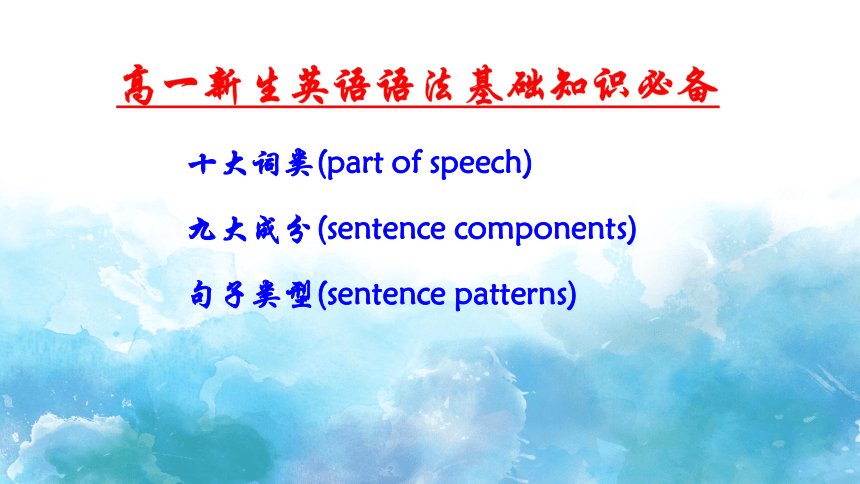 | |
| 格式 | pptx | ||
| 文件大小 | 25.2MB | ||
| 资源类型 | 教案 | ||
| 版本资源 | 通用版 | ||
| 科目 | 英语 | ||
| 更新时间 | 2024-07-22 22:35:27 | ||
图片预览

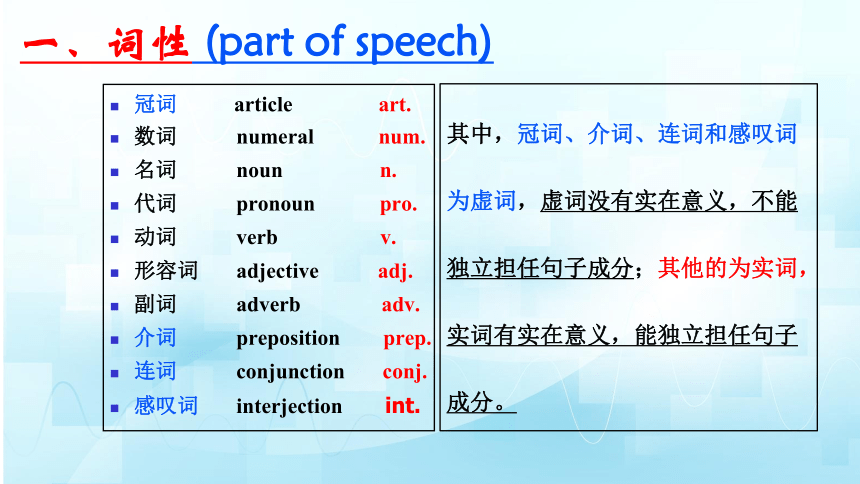
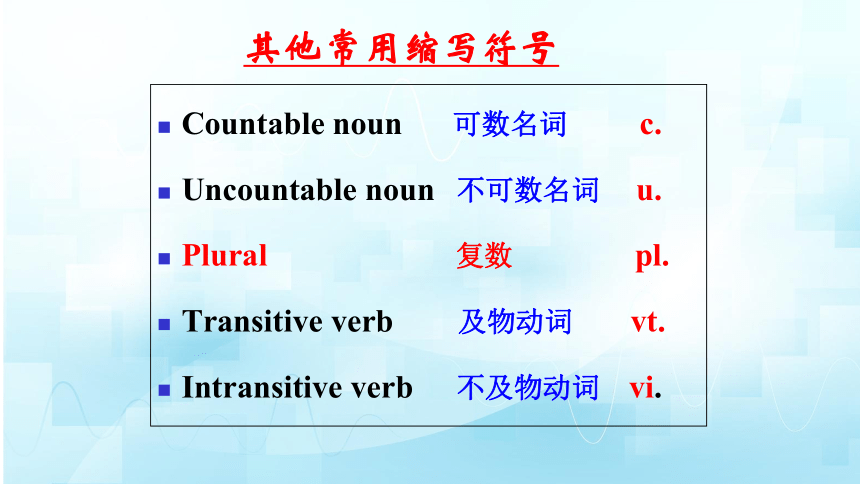
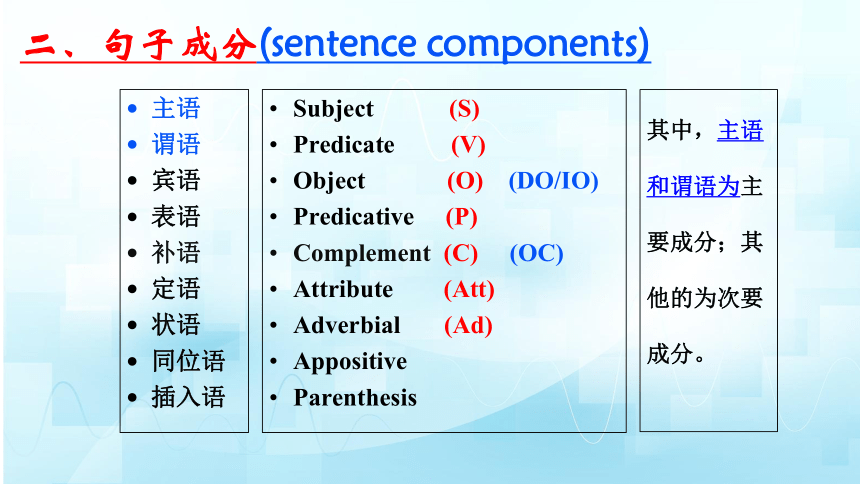
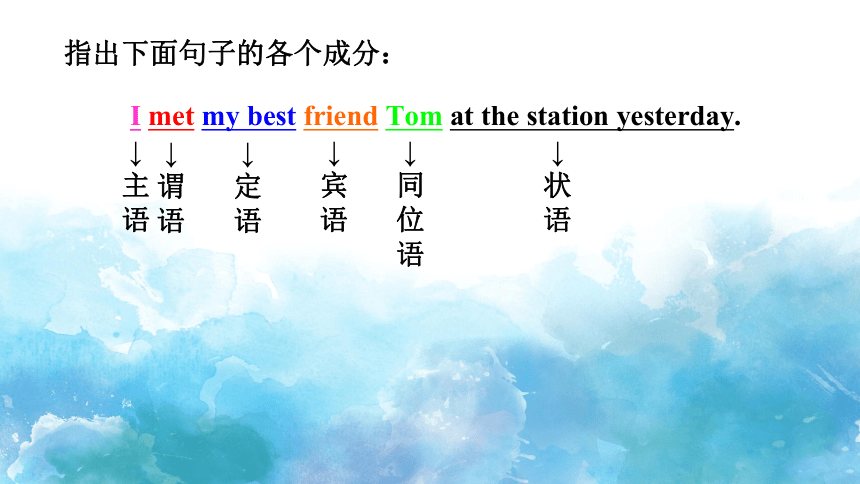
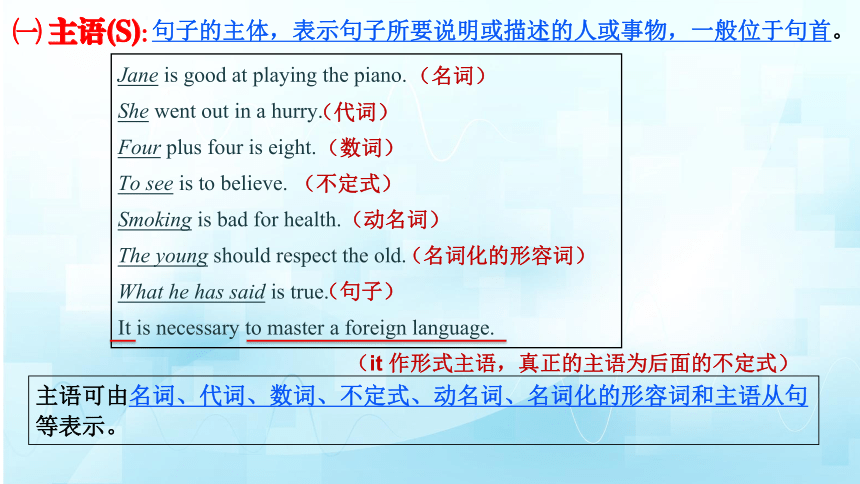
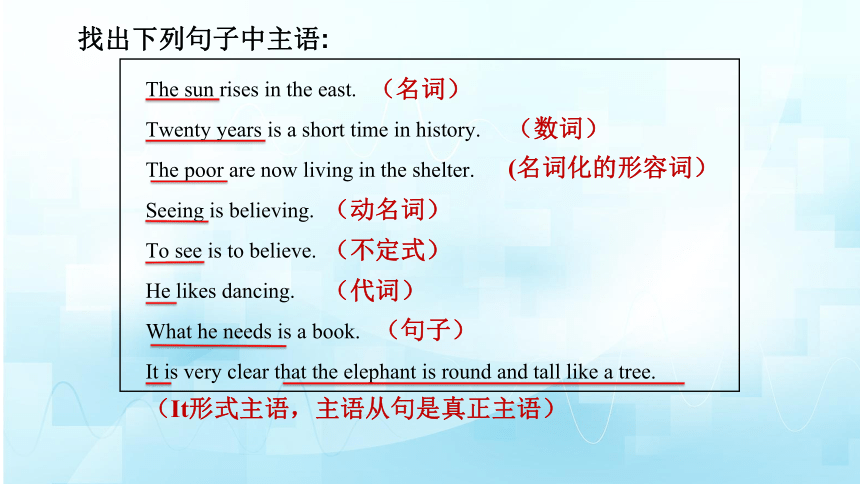
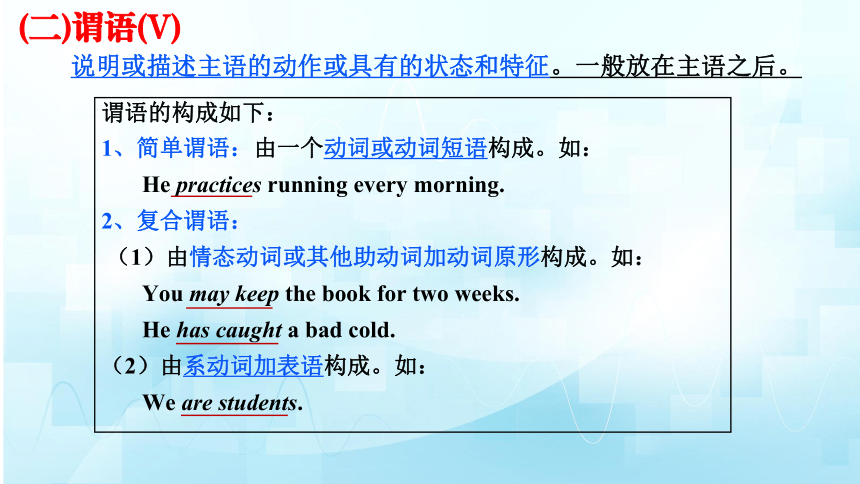



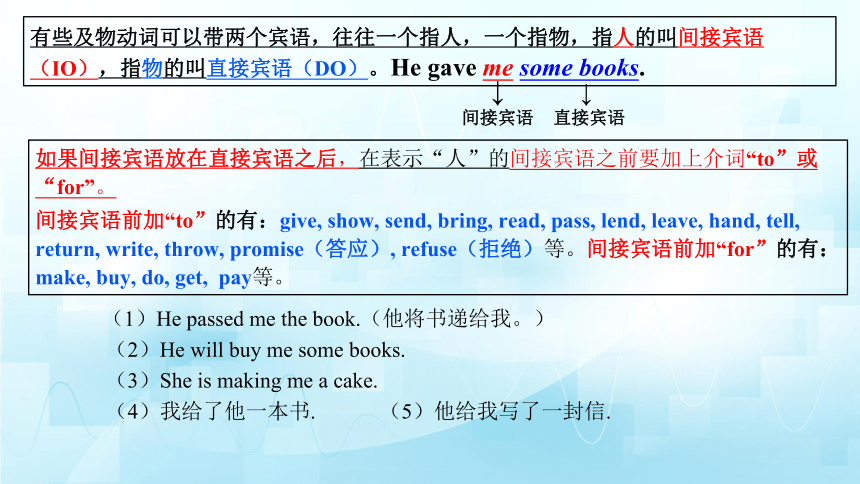
文档简介
(共34张PPT)
高一新生英语语法基础知识必备
十大词类(part of speech)
九大成分(sentence components)
句子类型(sentence patterns)
一、词性 (part of speech)
冠词 article art.
数词 numeral num.
名词 noun n.
代词 pronoun pro.
动词 verb v.
形容词 adjective adj.
副词 adverb adv.
介词 preposition prep.
连词 conjunction conj.
感叹词 interjection int.
其中,冠词、介词、连词和感叹词为虚词,虚词没有实在意义,不能独立担任句子成分;其他的为实词,实词有实在意义,能独立担任句子成分。
其他常用缩写符号
Countable noun 可数名词 c.
Uncountable noun 不可数名词 u.
Plural 复数 pl.
Transitive verb 及物动词 vt.
Intransitive verb 不及物动词 vi.
二、句子成分(sentence components)
主语
谓语
宾语
表语
补语
定语
状语
同位语
插入语
Subject (S)
Predicate (V)
Object (O) (DO/IO)
Predicative (P)
Complement (C) (OC)
Attribute (Att)
Adverbial (Ad)
Appositive
Parenthesis
其中,主语和谓语为主要成分;其他的为次要成分。
I met my best friend Tom at the station yesterday.
↓
主语
↓
谓
语
↓
定语
↓
宾
语
↓
同位语
↓
状
语
指出下面句子的各个成分:
Jane is good at playing the piano.
She went out in a hurry.
Four plus four is eight.
To see is to believe.
Smoking is bad for health.
The young should respect the old.
What he has said is true.
It is necessary to master a foreign language.
(名词)
(代词)
(数词)
(不定式)
(动名词)
(名词化的形容词)
(句子)
(it 作形式主语,真正的主语为后面的不定式)
主语可由名词、代词、数词、不定式、动名词、名词化的形容词和主语从句等表示。
㈠ 主语(S):
句子的主体,表示句子所要说明或描述的人或事物,一般位于句首。
找出下列句子中主语:
The sun rises in the east.
Twenty years is a short time in history.
The poor are now living in the shelter.
Seeing is believing.
To see is to believe.
He likes dancing.
What he needs is a book.
It is very clear that the elephant is round and tall like a tree.
(名词)
(代词)
(数词)
(动名词)
(不定式)
(句子)
(名词化的形容词)
(It形式主语,主语从句是真正主语)
(二)谓语(V)
谓语的构成如下:
1、简单谓语:由一个动词或动词短语构成。如:
He practices running every morning.
2、复合谓语:
(1)由情态动词或其他助动词加动词原形构成。如:
You may keep the book for two weeks.
He has caught a bad cold.
(2)由系动词加表语构成。如:
We are students.
说明或描述主语的动作或具有的状态和特征。一般放在主语之后。
Our teacher of English is an American.
Is it yours
The weather has turned cold.
The speech is exciting.
His job is to teach English.
The book is on the desk.
The truth is that he has never been abroad.
:表示主语的身份、性质、状态和特征,一般位于系动词(如be, become, get, look, grow, turn, seem等)之后。表语一般由名词、代词、形容词、分词、数词、不定式、动名词、介词短语、副词及表语从句表示,与系动词一起构成谓语。
(三)表语(P)
系动词
1)状态系动词(be动词)例如:He is a teacher. (is与表语一起说明主语的身份)
2)保持系动词 keep, remain, stay...
例如: He always kept silent at meeting.
3)表像系动词 seem, appear, look 例如: He looks tired.
4)感官系动词 look, sound, feel, smell, taste
例如:This kind of cloth feels very soft.
5)变化系动词 become, grow, turn, fall, get, go, come...
例如: He became mad after that.
6)终止系动词 prove, turn out, 表达“证实”,“变成”之意
例如: The rumor proved false.
注意:系动词不用于被动语态.
Show your passport, please.
She didn't say anything.
How many do you want - I want two.
They sent the injured to hospital.
They asked to see my passport.
I enjoy working with you.
Did you write down what he said
(名词 )
( 代词)
(数词)
(名词化的形容词)
(四)宾语(O)
(不定式短语)
(动名词短语)
(句子)
宾语一般由名词、代词或相当于名词的词组或句子充当。
表示动作行为的对象或承受者,经常位于及物动词或介词的后面。
如果间接宾语放在直接宾语之后,在表示“人”的间接宾语之前要加上介词“to”或“for”。
间接宾语前加“to”的有:give, show, send, bring, read, pass, lend, leave, hand, tell, return, write, throw, promise(答应), refuse(拒绝)等。间接宾语前加“for”的有:make, buy, do, get, pay等。
↓
间接宾语
↓
直接宾语
有些及物动词可以带两个宾语,往往一个指人,一个指物,指人的叫间接宾语(IO),指物的叫直接宾语(DO)。
(1)He passed me the book.(他将书递给我。)
(2)He will buy me some books.
(3)She is making me a cake.
(4)我给了他一本书. (5)他给我写了一封信.
He gave me some books.
(五)宾语补足语(OC)
有些及物动词的宾语后面还需要加一个宾语补足语意义才完整,所以宾语补足语用来对宾语进行补充和说明,一般由名词、非谓语动词、形容词等充当。例如:
His father named him Dongming.
They painted their boat white.
Let the fresh air in.
We saw her entering the room.
We found everything in good order.
(六)定语(Attr.)
He is a clever boy.
His father works in a steel work.
The girl in red is his sister.
He bought some sleeping pills.
Do you have time to help us
This is the book (which) you want.
(形容词)
(名词)
(介词短语)
(v-ing)
(不定式短语)
(定语从句)
单个的词做定语放在被修饰词之前;短语或句子作定语放在被修饰词之后。
对名词或代词进行修饰、限制或说明,一般由形容词、名词、代词、数词、介词短语、非谓语动词及句子等充当,位置可在所修饰的词之前,也可在所修饰的词之后。
n.作定语和adj.作定语的区别:
adj.作定语表示被修饰词的性质、特征等。clever boy, clean room,
beautiful flower
n.作定语表示被修饰词的作用、类别、材料、时间等。English book, paper flower, Evening news
Light travels most quickly.
He has lived in the city for ten years.
Once you begin, you must continue.
He got up early to catch the bus.
(七)状语 (Ad)
用于修饰动词、形容词、副词或整个句子等的句子成分。可以表示时间、地点、原因、条件、让步、目的、结果、程度、方式、伴随情况等,一般由副词、介词短语、非谓语动词短语或句子充当。
How about meeting again at six
Last night she didn’t go to the dance party because of the rain.
I shall go there if it doesn’t rain.
Mr Smith lives on the third floor.
She came in with a dictionary in her hand.
In order to catch up with the others, I must work harder.
She works very hard though she is old.
I am taller than he is.
She put the eggs into the basket with great care.
He was so tired that he fell asleep immediately.
说出下列状语种类:
We have a lot of machines on the farm.
These parties often make us very happy.
My brother takes care of the vegetable garden.
August is the hottest month here.
The boy over there is called Tom.
The farmer is showing the boy how to plant a tree.
指出下列句子成分:
Sentence patterns
句子类型
句子按其结构可分为下列三种类型:
1. 简单句(simple sentence),由一个主语(或并列主语)和一个谓语(或并列谓语)所组成,
如:
2.并列句(compound sentence),由两个或两个以上的简单句(即分句)组成,并且由并列连词
and, or, but, so, for等连接.如:
3.复合句(complex sentence),含有主从句的句子叫复合句。句子的某个成分由句子来充当,
这个句子叫从句,它所在的句子叫主句。从句在整个大句子中充当什么成分,就叫什么从
句。主句和从句之间有从属连词或关系代词连接。
She ate the food and he drank the beer. It is heavy, but I can manage (to carry it). Do you want a bath at once, or shall I have mine first It must be dawn, for the cock is singing.
They didn’t know the address, so they had to call her to pick them up at the railway station.
We (Amy and I) are friends. The baby laughed (and cried).
What he said yesterday surprised us a lot. I like the girl who is dancing with a boy. I often went to swim in the river when I was a child. I asked how they were getting on. You can take the photos where there are beautiful sceneries.
1.陈述句(declarative sentence),用以陈述事实,如: He came again the next morning. We had neither money nor food.
2.疑问句(interrogative sentence),用以提出问题,如: Are you free this evening When are you going to get your hair cut
3.祈使句(imperative sentence),用以表示请求、命令等,如: Don’t speak so loud. Be careful not to break anything.
4.感叹句(exclamatory sentence),用以表示各种强烈的感情,如: How hard he worked! 他多么肯干啊! What an opportunity! 多好的机会啊!
句子按其用途可分为下列四个种类:
1. S (subject) 主语 2. V (verb) 谓语动词
3. O (object) 宾语 4. P (predicative) 表语(系动词+n./adj.)
5. Ad (adverbial) 状语 6. DO 直接宾语(指物)
7. IO 间接宾语(指人) 8. OC 宾语补足语
简单句通常由以下八种成分构成:
简单句的基本结构
1. S+Vi 2. S+Vt+O
3. S+Lv/V+P 4. S +V+ IO+ DO
5. S+ V+ O+C 6. S+Vi+Ad
7. S+Vt+O+Ad 8. There be...
简单句通常有以下八种基本结构:
基本句型一: S十Vi (主谓结构)
这个句型中的谓语动词是不及物动词(短语), 后面不能直接带宾语,也没有被动语态, 此结构中常见的不及物动词有begin, arrive, come, go, live, rise, work, last, exist, agree, happen, break out, take place, come true等。
如: Class begins.
A Chinese painting exhibition will take place.
The boy's dream came true.
分析句子成分/判断正误
①The writing class had just begun.
②His | home broke out a fire last night. ( )
③A fire | broke out in his home last night. ( )
F
F
基本句型二: S十Vt十O(主谓宾结构)
此句型中的谓语动词必须是及物动词(短语),一般有被动语态。其后可接名词、代词、数词、动词不定式(to do)、动名词(v-ing)或从句作宾语。常见的动词如:help, have, respect, like, provide, own, think, believe, appreciate等 。
The students | have known | the answer.
He | said |“Good morning”.
You | should not give up | studying.
He | refused | to help them.
Tim | said | that he could speak Chinese.
1、我们学校将举办次运动会。
___________________________
2、我的爱好包括旅游和游泳。
___________________________
3、你知道他什么时候去的北京吗?
____________________________
4、父亲答应要给我一部手机。
____________________________
翻译下列句子
Our school will hold a sports meeting.
My hobbies include travelling and swimming.
Do you know when he left for Beijing
Father promised to give me a cell phone.
基本句型三:S十V/Lv十P(主系表结构)
This is a good story and it sounds very interesting.
主 系 表 主 系 表
此句型中谓语动词为系动词,用来说明主语的特征、状态、类属、身份等,此结构无被动语态。充当表语的可以是:名词,形容词,介词短语,从句, 非谓语动词等
(一)常见的连系动词(熟练背诵):
be 动词:am/is/are/was/were/have been/will be... (是…)+各种表语
感官系动词:look/sound/taste/smell/feel (…起来)+adj.
变化系动词:become (old/a doctor) /get(angry) /grow/turn(yellow) /come(true)/go(bad) /fall (asleep)等 (变得...)
保持系动词:keep/stay/remain(保持...)+adj.
表象系动词:seem/appear/look(看起来...)+adj.
She | is | an English teacher.
Your story | sounds | interesting.
His face | turned | red.
The baby | fell | asleep soon.
The girl | remained | awake all the night.
His advice | is | of great help.
My father's hope | is | that I can go home frequently.
分析句子成分并尝试翻译
① All of them were amazed.
翻译:__________________
② These suggestions are of great help.
翻译:__________________________
他们所有人都很吃惊。
这些建议很有帮助。
基本句型四:S十V十IO+DO(主谓宾宾)
此句型中的谓语动词为授予动词,后接双宾语才能表达完整的意思,间接宾语在前,直接宾语在后,但如果直接宾语在前,间接宾语在后,中间需要加上一个介词to 或for。
It | gives| her| a sense of duty.
The president | showed | me | her daughter's pictures.
Can you lend | me | that book
He | showed | me | how to run the machine.
I | told | him | that the bus was late.
I hope you | can tell me| the truth.=I hope you| can tell the truth | to me.
Her father | bought | her | a dictionary.=Her father| bought | a dictionary| for her.
分析句子成分/完成句子
①You had better buy your friends some small gifts.
②Besides,nothing could be better if you could________________________
(提供给我一些信息).
③I remember you_______________________(给我看了一些照片)on that theme.
offer me some informaton.
showed me some photos
基本句型五:S十V十O+Oc(主谓宾宾补)
此句型中谓语动词为不完全及物动词,主谓宾结构还不能表达完整的意思,必须加一个宾语补足语来说明宾语的情况才能使句子完整。宾语补足语可以由名词、形容词、非谓语动词、副词或介词短语等充当。该句式常用于三类动词①使役动词 make,let,have,leave,get,keep等。 ②感官动词或短语 see, watch, notice, find, observe, catch, look at, listen to,hear,feel,smell 等.③ ask,tell, order,request, permit, persuade 等。
They | usually keep | the door | open.
My teacher | had | me | standing all the morning.
He | made| the girl| cry just now.
I saw | them | getting on the bus.
He asked me | to come back soon.
Mum requested me | not to make noise.
翻译句子
①我们必须保持学校干净。
______________________________
②他父亲告诉他不要在街上玩耍。
______________________________
③每天早晨,我们都听到他大声朗读英语。
______________________________
We must keep our school clean.
His father told him not to play in the street.
We all hear him read English aloud every morning.
基本句型六:S十Vi十Ad(主谓状结构)
该句型的谓语动词通常为不及物动词; 副词或介词短语在句中作状语,修饰或说明谓语动词。
Everything | goes | well.
He | has been standing | there.
They | talked | for half an hour last night.
His parents | have worked | in the company for ten years.
She | was reading | when her mother came in.
【即时训练】 分析句子成分/完成句子
①The exhibition will start on June 21 and last for a week.
②Hopefully,you can take part.
③If accepted, _______________(我会努力工作)to offer you best articles.
I will work hard
该句型的谓语动词通常为及物动词;副词或介词短语在句中作状语,修饰或说明谓语动词。
The man | raised | his arms | above his head.
The girl | enjoys | reading | in the morning.
He | refused | to help them | at last.
基本句型七:S十Vt十O+Ad(主谓宾状结构)
She | was doing | her homework | at 8:00 last night.
分析句子成分/翻译句子
① One day some of my students were talking about what they would like to be in the future.
②我刚才看到她了。________________________________
③昨天,我拜访了一位朋友。__________________________________
I saw her just now.
I visited one of my friends yesterday.
There be句型表示“某处存在某物或某人”。基本结构是There is/are/was/ were ... 十地点状语。谓语动词有时候可用表示存在的其他动词,如 live,stand,lie,seem/ appear to be(好像有),happen to be(碰巧有),used to be(曾经有)等。
基本句型八:There be句型
There were two boys and a girl under the tree just now.
There goes the bell. Let's go into the lecture hall.
There seems to be a little dog under the desk.
There happened to be a man walking by.
完成句子
1. ______________________on the road. 路上的汽车太多了。
2. __________________more serious air pollution.空气污染将会更严重。
3. __________________a lack of communication.看来是缺乏沟通。
4. John opened the door. __________________ he had never seen before.
约翰打开门,他从来没见过的一个女孩站在那儿。
There are too many cars
There will be
There seems to be
There stood a girl
高一新生英语语法基础知识必备
十大词类(part of speech)
九大成分(sentence components)
句子类型(sentence patterns)
一、词性 (part of speech)
冠词 article art.
数词 numeral num.
名词 noun n.
代词 pronoun pro.
动词 verb v.
形容词 adjective adj.
副词 adverb adv.
介词 preposition prep.
连词 conjunction conj.
感叹词 interjection int.
其中,冠词、介词、连词和感叹词为虚词,虚词没有实在意义,不能独立担任句子成分;其他的为实词,实词有实在意义,能独立担任句子成分。
其他常用缩写符号
Countable noun 可数名词 c.
Uncountable noun 不可数名词 u.
Plural 复数 pl.
Transitive verb 及物动词 vt.
Intransitive verb 不及物动词 vi.
二、句子成分(sentence components)
主语
谓语
宾语
表语
补语
定语
状语
同位语
插入语
Subject (S)
Predicate (V)
Object (O) (DO/IO)
Predicative (P)
Complement (C) (OC)
Attribute (Att)
Adverbial (Ad)
Appositive
Parenthesis
其中,主语和谓语为主要成分;其他的为次要成分。
I met my best friend Tom at the station yesterday.
↓
主语
↓
谓
语
↓
定语
↓
宾
语
↓
同位语
↓
状
语
指出下面句子的各个成分:
Jane is good at playing the piano.
She went out in a hurry.
Four plus four is eight.
To see is to believe.
Smoking is bad for health.
The young should respect the old.
What he has said is true.
It is necessary to master a foreign language.
(名词)
(代词)
(数词)
(不定式)
(动名词)
(名词化的形容词)
(句子)
(it 作形式主语,真正的主语为后面的不定式)
主语可由名词、代词、数词、不定式、动名词、名词化的形容词和主语从句等表示。
㈠ 主语(S):
句子的主体,表示句子所要说明或描述的人或事物,一般位于句首。
找出下列句子中主语:
The sun rises in the east.
Twenty years is a short time in history.
The poor are now living in the shelter.
Seeing is believing.
To see is to believe.
He likes dancing.
What he needs is a book.
It is very clear that the elephant is round and tall like a tree.
(名词)
(代词)
(数词)
(动名词)
(不定式)
(句子)
(名词化的形容词)
(It形式主语,主语从句是真正主语)
(二)谓语(V)
谓语的构成如下:
1、简单谓语:由一个动词或动词短语构成。如:
He practices running every morning.
2、复合谓语:
(1)由情态动词或其他助动词加动词原形构成。如:
You may keep the book for two weeks.
He has caught a bad cold.
(2)由系动词加表语构成。如:
We are students.
说明或描述主语的动作或具有的状态和特征。一般放在主语之后。
Our teacher of English is an American.
Is it yours
The weather has turned cold.
The speech is exciting.
His job is to teach English.
The book is on the desk.
The truth is that he has never been abroad.
:表示主语的身份、性质、状态和特征,一般位于系动词(如be, become, get, look, grow, turn, seem等)之后。表语一般由名词、代词、形容词、分词、数词、不定式、动名词、介词短语、副词及表语从句表示,与系动词一起构成谓语。
(三)表语(P)
系动词
1)状态系动词(be动词)例如:He is a teacher. (is与表语一起说明主语的身份)
2)保持系动词 keep, remain, stay...
例如: He always kept silent at meeting.
3)表像系动词 seem, appear, look 例如: He looks tired.
4)感官系动词 look, sound, feel, smell, taste
例如:This kind of cloth feels very soft.
5)变化系动词 become, grow, turn, fall, get, go, come...
例如: He became mad after that.
6)终止系动词 prove, turn out, 表达“证实”,“变成”之意
例如: The rumor proved false.
注意:系动词不用于被动语态.
Show your passport, please.
She didn't say anything.
How many do you want - I want two.
They sent the injured to hospital.
They asked to see my passport.
I enjoy working with you.
Did you write down what he said
(名词 )
( 代词)
(数词)
(名词化的形容词)
(四)宾语(O)
(不定式短语)
(动名词短语)
(句子)
宾语一般由名词、代词或相当于名词的词组或句子充当。
表示动作行为的对象或承受者,经常位于及物动词或介词的后面。
如果间接宾语放在直接宾语之后,在表示“人”的间接宾语之前要加上介词“to”或“for”。
间接宾语前加“to”的有:give, show, send, bring, read, pass, lend, leave, hand, tell, return, write, throw, promise(答应), refuse(拒绝)等。间接宾语前加“for”的有:make, buy, do, get, pay等。
↓
间接宾语
↓
直接宾语
有些及物动词可以带两个宾语,往往一个指人,一个指物,指人的叫间接宾语(IO),指物的叫直接宾语(DO)。
(1)He passed me the book.(他将书递给我。)
(2)He will buy me some books.
(3)She is making me a cake.
(4)我给了他一本书. (5)他给我写了一封信.
He gave me some books.
(五)宾语补足语(OC)
有些及物动词的宾语后面还需要加一个宾语补足语意义才完整,所以宾语补足语用来对宾语进行补充和说明,一般由名词、非谓语动词、形容词等充当。例如:
His father named him Dongming.
They painted their boat white.
Let the fresh air in.
We saw her entering the room.
We found everything in good order.
(六)定语(Attr.)
He is a clever boy.
His father works in a steel work.
The girl in red is his sister.
He bought some sleeping pills.
Do you have time to help us
This is the book (which) you want.
(形容词)
(名词)
(介词短语)
(v-ing)
(不定式短语)
(定语从句)
单个的词做定语放在被修饰词之前;短语或句子作定语放在被修饰词之后。
对名词或代词进行修饰、限制或说明,一般由形容词、名词、代词、数词、介词短语、非谓语动词及句子等充当,位置可在所修饰的词之前,也可在所修饰的词之后。
n.作定语和adj.作定语的区别:
adj.作定语表示被修饰词的性质、特征等。clever boy, clean room,
beautiful flower
n.作定语表示被修饰词的作用、类别、材料、时间等。English book, paper flower, Evening news
Light travels most quickly.
He has lived in the city for ten years.
Once you begin, you must continue.
He got up early to catch the bus.
(七)状语 (Ad)
用于修饰动词、形容词、副词或整个句子等的句子成分。可以表示时间、地点、原因、条件、让步、目的、结果、程度、方式、伴随情况等,一般由副词、介词短语、非谓语动词短语或句子充当。
How about meeting again at six
Last night she didn’t go to the dance party because of the rain.
I shall go there if it doesn’t rain.
Mr Smith lives on the third floor.
She came in with a dictionary in her hand.
In order to catch up with the others, I must work harder.
She works very hard though she is old.
I am taller than he is.
She put the eggs into the basket with great care.
He was so tired that he fell asleep immediately.
说出下列状语种类:
We have a lot of machines on the farm.
These parties often make us very happy.
My brother takes care of the vegetable garden.
August is the hottest month here.
The boy over there is called Tom.
The farmer is showing the boy how to plant a tree.
指出下列句子成分:
Sentence patterns
句子类型
句子按其结构可分为下列三种类型:
1. 简单句(simple sentence),由一个主语(或并列主语)和一个谓语(或并列谓语)所组成,
如:
2.并列句(compound sentence),由两个或两个以上的简单句(即分句)组成,并且由并列连词
and, or, but, so, for等连接.如:
3.复合句(complex sentence),含有主从句的句子叫复合句。句子的某个成分由句子来充当,
这个句子叫从句,它所在的句子叫主句。从句在整个大句子中充当什么成分,就叫什么从
句。主句和从句之间有从属连词或关系代词连接。
She ate the food and he drank the beer. It is heavy, but I can manage (to carry it). Do you want a bath at once, or shall I have mine first It must be dawn, for the cock is singing.
They didn’t know the address, so they had to call her to pick them up at the railway station.
We (Amy and I) are friends. The baby laughed (and cried).
What he said yesterday surprised us a lot. I like the girl who is dancing with a boy. I often went to swim in the river when I was a child. I asked how they were getting on. You can take the photos where there are beautiful sceneries.
1.陈述句(declarative sentence),用以陈述事实,如: He came again the next morning. We had neither money nor food.
2.疑问句(interrogative sentence),用以提出问题,如: Are you free this evening When are you going to get your hair cut
3.祈使句(imperative sentence),用以表示请求、命令等,如: Don’t speak so loud. Be careful not to break anything.
4.感叹句(exclamatory sentence),用以表示各种强烈的感情,如: How hard he worked! 他多么肯干啊! What an opportunity! 多好的机会啊!
句子按其用途可分为下列四个种类:
1. S (subject) 主语 2. V (verb) 谓语动词
3. O (object) 宾语 4. P (predicative) 表语(系动词+n./adj.)
5. Ad (adverbial) 状语 6. DO 直接宾语(指物)
7. IO 间接宾语(指人) 8. OC 宾语补足语
简单句通常由以下八种成分构成:
简单句的基本结构
1. S+Vi 2. S+Vt+O
3. S+Lv/V+P 4. S +V+ IO+ DO
5. S+ V+ O+C 6. S+Vi+Ad
7. S+Vt+O+Ad 8. There be...
简单句通常有以下八种基本结构:
基本句型一: S十Vi (主谓结构)
这个句型中的谓语动词是不及物动词(短语), 后面不能直接带宾语,也没有被动语态, 此结构中常见的不及物动词有begin, arrive, come, go, live, rise, work, last, exist, agree, happen, break out, take place, come true等。
如: Class begins.
A Chinese painting exhibition will take place.
The boy's dream came true.
分析句子成分/判断正误
①The writing class had just begun.
②His | home broke out a fire last night. ( )
③A fire | broke out in his home last night. ( )
F
F
基本句型二: S十Vt十O(主谓宾结构)
此句型中的谓语动词必须是及物动词(短语),一般有被动语态。其后可接名词、代词、数词、动词不定式(to do)、动名词(v-ing)或从句作宾语。常见的动词如:help, have, respect, like, provide, own, think, believe, appreciate等 。
The students | have known | the answer.
He | said |“Good morning”.
You | should not give up | studying.
He | refused | to help them.
Tim | said | that he could speak Chinese.
1、我们学校将举办次运动会。
___________________________
2、我的爱好包括旅游和游泳。
___________________________
3、你知道他什么时候去的北京吗?
____________________________
4、父亲答应要给我一部手机。
____________________________
翻译下列句子
Our school will hold a sports meeting.
My hobbies include travelling and swimming.
Do you know when he left for Beijing
Father promised to give me a cell phone.
基本句型三:S十V/Lv十P(主系表结构)
This is a good story and it sounds very interesting.
主 系 表 主 系 表
此句型中谓语动词为系动词,用来说明主语的特征、状态、类属、身份等,此结构无被动语态。充当表语的可以是:名词,形容词,介词短语,从句, 非谓语动词等
(一)常见的连系动词(熟练背诵):
be 动词:am/is/are/was/were/have been/will be... (是…)+各种表语
感官系动词:look/sound/taste/smell/feel (…起来)+adj.
变化系动词:become (old/a doctor) /get(angry) /grow/turn(yellow) /come(true)/go(bad) /fall (asleep)等 (变得...)
保持系动词:keep/stay/remain(保持...)+adj.
表象系动词:seem/appear/look(看起来...)+adj.
She | is | an English teacher.
Your story | sounds | interesting.
His face | turned | red.
The baby | fell | asleep soon.
The girl | remained | awake all the night.
His advice | is | of great help.
My father's hope | is | that I can go home frequently.
分析句子成分并尝试翻译
① All of them were amazed.
翻译:__________________
② These suggestions are of great help.
翻译:__________________________
他们所有人都很吃惊。
这些建议很有帮助。
基本句型四:S十V十IO+DO(主谓宾宾)
此句型中的谓语动词为授予动词,后接双宾语才能表达完整的意思,间接宾语在前,直接宾语在后,但如果直接宾语在前,间接宾语在后,中间需要加上一个介词to 或for。
It | gives| her| a sense of duty.
The president | showed | me | her daughter's pictures.
Can you lend | me | that book
He | showed | me | how to run the machine.
I | told | him | that the bus was late.
I hope you | can tell me| the truth.=I hope you| can tell the truth | to me.
Her father | bought | her | a dictionary.=Her father| bought | a dictionary| for her.
分析句子成分/完成句子
①You had better buy your friends some small gifts.
②Besides,nothing could be better if you could________________________
(提供给我一些信息).
③I remember you_______________________(给我看了一些照片)on that theme.
offer me some informaton.
showed me some photos
基本句型五:S十V十O+Oc(主谓宾宾补)
此句型中谓语动词为不完全及物动词,主谓宾结构还不能表达完整的意思,必须加一个宾语补足语来说明宾语的情况才能使句子完整。宾语补足语可以由名词、形容词、非谓语动词、副词或介词短语等充当。该句式常用于三类动词①使役动词 make,let,have,leave,get,keep等。 ②感官动词或短语 see, watch, notice, find, observe, catch, look at, listen to,hear,feel,smell 等.③ ask,tell, order,request, permit, persuade 等。
They | usually keep | the door | open.
My teacher | had | me | standing all the morning.
He | made| the girl| cry just now.
I saw | them | getting on the bus.
He asked me | to come back soon.
Mum requested me | not to make noise.
翻译句子
①我们必须保持学校干净。
______________________________
②他父亲告诉他不要在街上玩耍。
______________________________
③每天早晨,我们都听到他大声朗读英语。
______________________________
We must keep our school clean.
His father told him not to play in the street.
We all hear him read English aloud every morning.
基本句型六:S十Vi十Ad(主谓状结构)
该句型的谓语动词通常为不及物动词; 副词或介词短语在句中作状语,修饰或说明谓语动词。
Everything | goes | well.
He | has been standing | there.
They | talked | for half an hour last night.
His parents | have worked | in the company for ten years.
She | was reading | when her mother came in.
【即时训练】 分析句子成分/完成句子
①The exhibition will start on June 21 and last for a week.
②Hopefully,you can take part.
③If accepted, _______________(我会努力工作)to offer you best articles.
I will work hard
该句型的谓语动词通常为及物动词;副词或介词短语在句中作状语,修饰或说明谓语动词。
The man | raised | his arms | above his head.
The girl | enjoys | reading | in the morning.
He | refused | to help them | at last.
基本句型七:S十Vt十O+Ad(主谓宾状结构)
She | was doing | her homework | at 8:00 last night.
分析句子成分/翻译句子
① One day some of my students were talking about what they would like to be in the future.
②我刚才看到她了。________________________________
③昨天,我拜访了一位朋友。__________________________________
I saw her just now.
I visited one of my friends yesterday.
There be句型表示“某处存在某物或某人”。基本结构是There is/are/was/ were ... 十地点状语。谓语动词有时候可用表示存在的其他动词,如 live,stand,lie,seem/ appear to be(好像有),happen to be(碰巧有),used to be(曾经有)等。
基本句型八:There be句型
There were two boys and a girl under the tree just now.
There goes the bell. Let's go into the lecture hall.
There seems to be a little dog under the desk.
There happened to be a man walking by.
完成句子
1. ______________________on the road. 路上的汽车太多了。
2. __________________more serious air pollution.空气污染将会更严重。
3. __________________a lack of communication.看来是缺乏沟通。
4. John opened the door. __________________ he had never seen before.
约翰打开门,他从来没见过的一个女孩站在那儿。
There are too many cars
There will be
There seems to be
There stood a girl
同课章节目录
